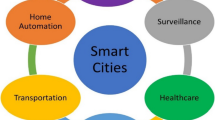Abstract
Smart city is an emerging research field nowadays, with emphasis of using big data to enhance citizens’ quality of life. One of the prevalent smart city projects is to use big traffic data collected from road users over time, for road planning, traffic light scheduling, traffic jam relief, and public security. In particular, being able to know a road user’s current location and predict his/her next move is important in today’s intelligent transportation systems. Trajectory prediction has become a prudential research study direction, by which many algorithms have been published before. In this paper, we present a simple probabilistic model which predicts road users’ next locations based on the “concept of segments” abstracted from historical trails which the users have taken and accumulated over time in some data archive. Given a trajectory and a current location, the road user’s next move in terms of road direction can be predicted at the junction. It is found that each road user would have his/her unique travel pattern hidden in the aggregate big traffic data. These patterns could be modeled from connected segments for simplicity. With the longer the trail and more frequently this trail was travelled, the more accurate that the next turn can be predicted. Simulation experiment was conducted based on summing up the segments from empirical trajectory data that was used in trajectory data mining by Microsoft. The results of our alternative model in contrast to the state of the arts demonstrated good efficacy.







Similar content being viewed by others
References
Manaka A, Ishii H, Chow CO, Utsu K (2016) Concepts, services, and underlying network for a daily life support system for citizens. J Supercomput 72(4):1381–1398
Jaehak Y, Bang H-C, Lee H, Lee YS (2016) Adaptive internet of things and web of things convergence platform for internet of reality services. J Supercomput 72(1):84–102
Lee C, Han K, Li J (2016) Editorial: a special section on ”Emerging platform technologies”. J Supercomput 72(1):1–4
Feese S, Burscher MJ, Jonas K, Tröster G (2014) Sensing spatial and temporal coordination in teams using the smartphone. Hum Cent Comput Inf Sci 4(15):1–18
Smyth S (2000) Mobile geographic information services: turning GIS inside out. Microsoft Report
Joseph AD (2006) Intelligent transportation systems. IEEE J Pervasive Comput 5(4):63–67
Dey A, Hightower J, de Nigel LED (2010) Location-based services. IEEE J Pervasive Comput 9(1):11–12
Deguchi Y, Kuroda K, Shouji M, Kawabe T (2004) HEV charge/discharge control system based on car navigation information. SAE Convergence International Congress & Exposition on Transportation Electronics, 21-0028, pp 1–7
Tate ED, Boyd SP (2000) Finding ultimate limits of performance for hybrid electric vehicles. Technical Report, SAE 2000-01-3099
Pu Y, Huaqun G, Wong W-C (2010) 5th International Conference on Computer Sciences and Convergence Information Technology (ICCIT), 30 Nov-2 Dec 2010, pp 135–140
Liao a L, Patterson b DJ, Fox a D, Kautz H (2007) Learning and inferring transportation routines. Artif Intell 171(5–6):311–331
Jeung H, Yiu ML, Zhou X (2010) Path prediction and predictive range querying in road network databases. VLDB J 19(4):585–602
Anagnostopoulos I, Zeadally S, Exposito E (2016) Handling big data: research challenges and future directions. J Supercomput 72(4):1494–1516
Cyrus S, Kim SH, Luciano N, Constantinou Giorgos L, Ying CY, Gérard M, Ramakant N, Farnoush B-K (2014) Janus—multi source event detection and collection system for effective surveillance of criminal activity. J Inf Process Syst 10(1):1–22
Sung Y, Chul S (2015) Recommender system using periodicity analysis via mining sequential patterns with time-series and FRAT analysis. J Converg 6(1):1–9
Loke SW (2016) Heuristics for spatial finding using iterative mobile crowdsourcing. Hum Cent Comput Inf Sci 6(4):1–31
Liu X, Karimi HA (2006) Location awareness through trajectory prediction. Comput Environ Urban Syst 30(6):741–756
Ye Q, Chen L, Chen G (2008) Predict personal continuous route. 11th International IEEE Conference on Intelligent Transportation Systems, pp 587–592
Anagnostopoulos T, Anagnostopoulos CB, Hadjiefthymiades S, Kalousis A, Kyriakakos M (2007) Path prediction through data mining. IEEE International Conference on Pervasive Services, pp 128–135
Lee J, Chae H, Hong K (2015) A fainting condition detection system using thermal imaging cameras based object tracking algorithm. J Converg 6(3):1–15
Park S, Kim S, Ha Y (2016) Highway traffic accident prediction using VDS big data analysis. J Supercomput 72(7):2832–2832
Mazhar Rathore M, Ahmad A, Paul A (2016) Real time intrusion detection system for ultra-high-speed big data environments. J Supercomput 72(9):3489–3510
Kim D-H, Choi K-H, Li K-J, Lee Y-S (2015) Performance of vehicle speed estimation using wireless sensor networks: a region-based approach. J Supercomput 71(6):2101–2120
Acknowledgements
The authors of this paper are thankful to the financial supports of the grant offered with code: MYRG2015-00024, called “Building Sustainable Knowledge Networks through Online Communities,” by RDAO, University of Macau. We acknowledge and thank you for the intellectual and technical contributions from Mr. Jia Cong Mao who is a software engineer of DACC laboratory and MSc graduate from the University of Macau.
Author information
Authors and Affiliations
Corresponding author
Appendix
Appendix





Rights and permissions
About this article
Cite this article
Zhuang, Y., Fong, S., Yuan, M. et al. Predicting the next turn at road junction from big traffic data. J Supercomput 73, 3128–3148 (2017). https://doi.org/10.1007/s11227-017-2013-y
Published:
Issue Date:
DOI: https://doi.org/10.1007/s11227-017-2013-y




